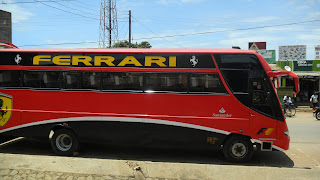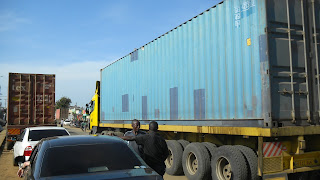Day 41-Thursday, November 1-Ol Moran Tented Camp, Masai Mara National Reserve
How can I describe what an amazing experience we've had viewing wildlife in Masai Mara National Reserve over the last 2 days? I'm afraid I'll run out of superlatives. Maybe a short description, then I'll let the photos speak for themselves:
 |
| This grazing herd completely surrounded us at one point |
 |
| Lion prints in mud was promise of what was to come! |
 |
| Cub drinking after gorging itself-it's belly was so round! |
 |
| King of beasts |
 |
| Hippos resting on shore of Mara River-they travel 10-15 km at night to graze |
 |
| Amazing lizard on rock near Mara River |
 |
| Two cheetahs resting-must have fed earlier |
 |
| Family group |
 |
| Entrance to Masai Mara National Preserve |
 |
| 3 weeks after the major wildebeest migration-still saw 1,000s |
Wildebeests-Thousands & thousands everywhere...and these are the stragglers from the major migration of millions of animals that occurred 3 weeks ago as they began their return journey to the Serengeti Plains in Tanzania immediately south of Masai Mara. They will return north in June.
Lions-Close-up views 2 major prides after they'd made kills; one was lazing around, obviously stuffed, while the 2nd was in the midst of tearing apart a wildebeest the lionesses had killed 1-2 hours previously. Neither seemed concerned in the slightest in our presence. We got fabulous photos & videos. You will be amazed! Viewed another group of 4 females in open grassland; however, they seemed interested in us (looking at us as possible prey?), making us think it had been a while since they'd eaten!
Elephants-many different herds: one large herd walked towards our open-topped vehicle as they grazed & seemed completely unconcerned; at one point we were completely surrounded by them; another smaller herd gathered in the shade of an acacia tree, rubbing against its bark with their skin; that group of females included a small calf & an adolescent in addition to moms & aunties.
Giraffes-so many different groups; so graceful as they walked by us, seemingly in slow motion.
 |
| BIG croc next to Mara River |
Hippos & a huge crocodile-along the banks of the Mara River.
Cheetahs-observed a a female & her adolescent offspring, lazing in the sun, apparently stuffed after a kill, resting, unconcerned by our vehicle & our presence; but I noticed their rapid respiration rate (being the good nurse that I am) and counted them (~128 breaths/minute).
Servile cats-saw 2 of these elusive, solitary cats our guide says are rare to see; warthogs-frequently saw a mother followed by numerous piglets (?).
Zebras, Cape buffaloes, Thompson gazelles, impalas-too numerous to count or describe.














































